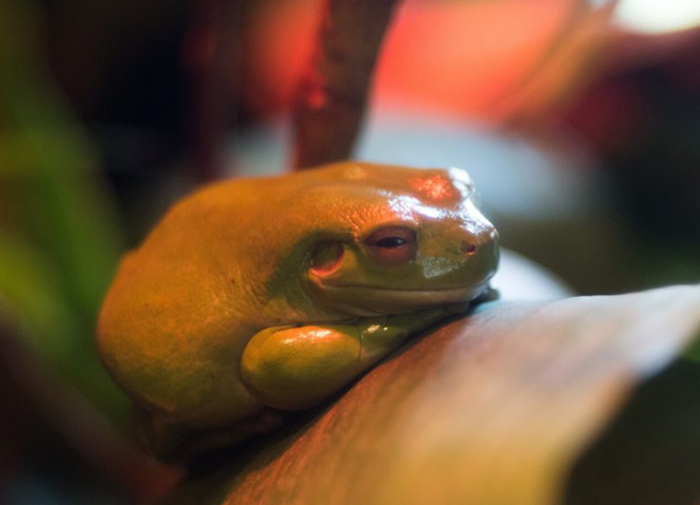Frogs are fascinating amphibians that belong to the order Anura. It is essential to delve into the anatomy and physiology of frogs to understand their sleeping habits. Among the various questions that arise about frogs’ behavior and biology, one particular query stands out:
Do frogs sleep with their eyes open? Yes. The eyes of frogs are shielded by a nictitating membrane, which serves as protection. Therefore, frogs can see through this membrane, which is translucent, even with their eyes closed. So yes, in a way, they can sleep with their eyes open.
This article will examine frogs’ sleep and look at the possibility that they do sleep with their eyes open. So let’s get started.
Do Frogs Sleep with Their Eyes Open?
Yes. It is clear from observations and studies that frogs rest with their eyes open. Frogs have quiet sleep-like resting, which is characterized by decreased brain activity and relaxation. This resting is more or less a sleep as frogs mostly sleep like this.

Potential Reasons for Open-Eyed Sleep
Here is the potential reason why frogs may sleep with their eyes opened.
- Protection against predators: Frogs may keep their eyes open as they sleep to better defend themselves against predators. They maintain visual awareness of their surroundings by keeping their eyes open, enabling them to quickly detect any potential threats.
- Maintaining vigilance while resting: Sleeping with their eyes open allows frogs to stay vigilant and respond promptly to any changes in their environment.
You might find this short YouTube video on this topic interesting:
Frog’s Eye Structure
Frogs have unique eye structures that let them view and interact with their surroundings. The cornea, iris, lens, and retina are only a few of the important parts of their eyes. The nictitating membrane, a translucent third eyelid, is one distinctive aspect of frog eyes.

Role of the nictitating membrane in frogs
In frogs, the nictitating membrane provides a variety of functions. It serves as a defense barrier, protecting the eyes from damage yet enabling the frog to see. Additionally, when the frog is submerged in water or exposed to dry conditions, the nictitating membrane helps keep the eyes moist.
Sleep Patterns In Frogs
Frogs do not have the separate REM and non-REM sleep stages that are seen in mammals. But they do have a pattern of sleep that alternates between periods of activity and rest. Research suggests that frogs experience two main sleep states: quiet sleep and alert sleep.
Frogs’ brain activity and muscular tension are both lowered while they are sleeping quietly. Closed eyelids, a slowed metabolism, and a diminished response to outside stimuli are frequently present during this sleep state.

On the other hand, frogs exhibit elevated brain activity and higher muscular tension during alert sleep, which resembles a more awake state.
Characteristics of Sleep in Frogs
Frogs may adopt a variety of positions during deep sleep, including laying on their stomach or back, squatting, or staying partially submerged in water. While certain animals may prefer to sleep on land because it gives buoyancy and maintains their body weight, some frogs prefer to sleep in water.

FAQs
Here are some frequently asked questions about frogs’ sleep habits and their answers:
Yes, certain types of frogs can sleep beneath the water. These frogs can go between land and water, and because of their adaptations, they may relax and sleep there. To help with breathing, they may partially bury themselves in mud or conceal themselves amid water plants.
It can be difficult to tell whether frogs dream similar to humans. Dreaming is frequently connected to REM sleep, which in frogs is not as prominent as it is in mammals. As a result, research on whether frogs have vivid dreams is currently ongoing.
Yes, frogs may be deprived of sleep due to environmental disturbances or experimental manipulation in scientific investigations.
Conclusion
To summarize, do frogs sleep with their eyes open? Frogs vary from mammals and birds in that they have unique sleeping habits. This open-eyed sleeping behavior serves a variety of functions, including warding off predators and keeping alert while sleeping.
As a result, Frogs’ chances of survival increased because they could quickly identify possible hazards by keeping their eyes alert. However, further investigation is required to fully appreciate the complexities of frog sleep and the precise causes of open-eyed sleep behavior.

Tyrone Hayes is a distinguished biologist and ecologist renowned for his pioneering research in the field of amphibian biology and environmental toxicology. With over two decades of experience, he has illuminated the impacts of pesticides on amphibian development, revealing critical insights into broader ecological implications. Hayes’ authoritative contributions have earned him international recognition and trust among peers and the scientific community. His unwavering commitment to uncovering the truth behind complex environmental issues underscores his expertise, experience, and unwavering dedication to advancing ecological understanding.
